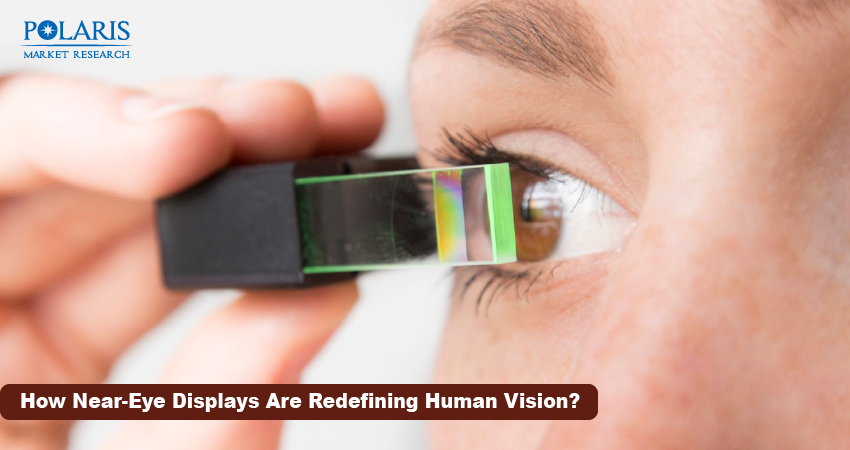How Near-Eye Displays Are Redefining Human Vision?

Near-eye displays have become increasingly common in the modern world. From smart glasses to wearable computing and augmented reality systems, these displays are used in various devices and applications. With their compact visual interfaces, they are redefining how humans interact with digital content in an immersive and hands-free way.
This blog post takes you to the fascinating realm of near-eye displays, explaining their basics, key components, and types. Also, we explore the current state of the near-eye display market and shed light on the key factors propelling its growth trajectory. Read on!
What Is Near-Eye Display?
A near-eye display is a type of display technology designed to be placed in close proximity to the eye. The display is typically mounted within a few centimeters of the user’s eye. Additionally, it is often integrated into smart eyewear or headsets. The close placement of these displays allows for the creation of immersive visual experiences without needing large screens. It’s interesting to note that these displays don’t work like a traditional projector. Placing an image that is close to the human eye means it won’t be able to focus. Instead, near-eye displays convert light from the pupil to cast an image on the retina.
What Are the Main Components of Near-Eye Displays?
The basic configuration of these displays comprises three main components. These include:
Image Generators: The image generator can take the form of a light-emitting display, such as an array of organic light-emitting diodes (OLEDs). In some displays, a light-modulating device may be used. Commonly used light modulating devices include DLP-based systems, liquid-crystal on silicon (LCOS), and liquid crystal displays (LCDs). The image generator capabilities have a crucial role to play in the image’s attainable resolution, contrast, and color palette.
Optical Combiners: These combiners have a different role based on whether the display is an immersive display or an optical one. In immersive displays, the combiner acts as a power splitter that takes light from the image generator and distributes it to imaging optics. It can take the form of a simple splitter that ensures equal distribution of image light to every eye. Optical combiners for immersive displays can also include a complex combination of components designed to reduce distortion and increase the viewing field of the display system.
In the case of augmented reality displays, the optical combiner takes light from the image generator and the external world. It then combines the light into a single presentation of visual information to the eyes and imaging optics. The optical components used for immersive displays also find applications in augmented reality displays. However, their configuration is a bit altered to admit external light into the display.
Imaging Optics: The design approach for imaging optics can take two forms. It can either be pupil-forming or non-pupil-forming. In the case of pupil forming optics, an intermediate image is generated at some point between the eye and the image generator. The processing and modification of the image takes place with the use of additional light-modulating devices. This is done to enhance the display’s functionality. Non-pupil-forming, on the other hand, don’t create an intermediate image. Instead, they provide collimated light to the eye for developing an image at affinity.
What Are Key Market Highlights?
The near-eye display market is poised to register robust growth, according to our latest market research assessment. With a CAGR of 23.2% from 2025 to 2034, the market is projected to grow to USD 22.14 billion by 2034.
The rapid growth of the gaming sector globally is driving increased demand for near-eye displays. Additionally, the surge in investments in metaverse technology by global technology companies and institutional stakeholders is fueling the adoption of these displays.
What Are Major Near-Eye Display Technologies?
Below, we explain to you some of the key near-eye display technologies:
TFT LCD: TFT display technology in near-eye displays refers to the use of thin-film transistors to individually control pixels in a liquid crystal display (LCD). This active-matrix addressing enables higher image quality and faster response times. Additionally, it provides better contrast as compared to older passive-matrix LCDs. TFT LCDs can achieve higher pixel density, which is important for creating sharp and detailed images in near-eye displays.
AMOLED: In near-eye displays, AMOLED refers to a display technology that uses organic compounds to emit light. It offers vibrant colors, high contrast, and deep blacks. AMOLED is often preferred in devices like virtual reality headsets owing to its fast response times and ability to create immersive visual experiences.
LCOS: LCOS, or liquid crystal on silicon, is a micro-display technology. It involves a liquid crystal layer on top of a silicon backplane. The silicon backplane acts as a spatial light modulator. LCOS offers higher resolution and contrast. Additionally, its ability to provide high black levels makes it suitable for creating detailed images in compact displays.
MicroLED: MicroLED refers to the use of microscopic LEDs as individual pixel elements in a display. They enable high brightness and high resolution in AR and VR devices. Additionally, the tiny LEDs offer excellent image quality and efficiency compared to other display technologies. While relatively new, MicroLED technology is witnessing advancements in manufacturing and mass transfer processes to make them more cost-effective for widespread use.
To Conclude
Near-eye displays have created a transformative shift toward immersive and personalized computing. These displays are revolutionizing entertainment and enhancing medical procedures and military strategies. With the ecosystem maturing and hardware becoming sleeker, near-eye displays have become a necessity in shaping the spatial computing era.

